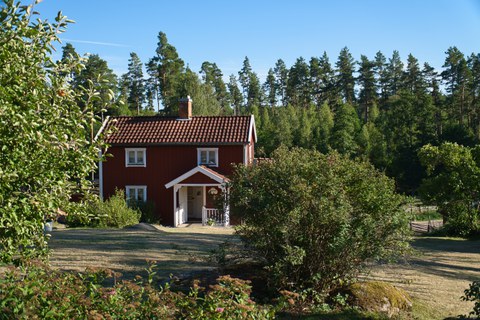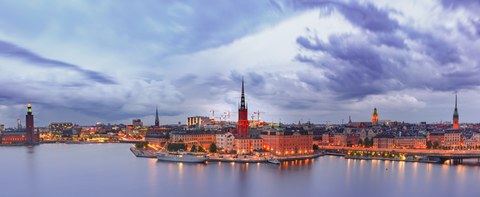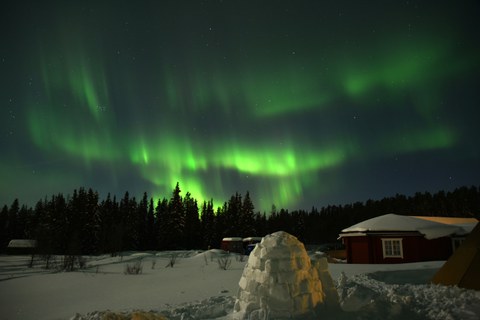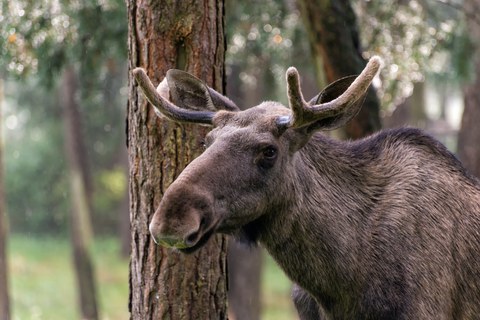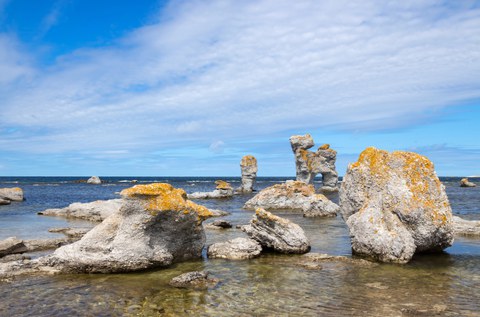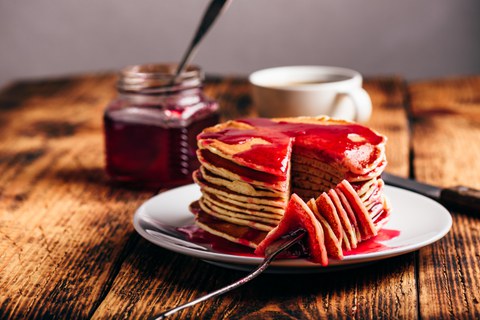Partnerland des Monats Juli 2021: Schweden
Schweden, das Land von Elchtests, IKEA und Astrid Lindgren, hat einen guten Ruf. Die skandinavischen Länder belegen regelmäßig die vordersten Plätze in Rankings von Lebensqualität, Geschlechtergleichstellung und allgemeinem Wohlstand. Auch hat das dünn besiedelte Schweden sehr viel Natur zu bieten, ganze 15% der Landesfläche zählen als Nationalpark. In der schwedischen Kultur und Geschichte gibt es viel zu entdecken - wusstest du zum Beispiel, dass Schweden die weltweit zweithöchste Dichte von Metalbands pro Einwohnern hat?
Mit der Aktion "Partnerland des Monats" richten wir den Scheinwerfer auf die große Vielfalt der Länder, Regionen und Partneruniversitäten der TU Dresden, in denen unsere Studierenden ein Auslandssemester verbringen können.
Inhaltsverzeichnis
Allgemeine Zahlen und Fakten zu Schweden
Hauptstadt: Stockholm
Einwohner: 10,3 Millionen
Amtssprache: Schwedisch, regional auch Samisch, Finnisch und Meänkieli
Nationalfeiertag: 6. Juni
Währung: Schwedische Krone (kr)
Weitere Zahlen, Fakten und Infos findest du auf Wikipedia, bei den DAAD-Länderinformationen oder z.B. bei visitsweden.de.
Kleiner Sprachexkurs
- Hallo - Hej
- Wie geht’s? - Hur är läget?
- Mein Name ist … - Jag heter ...
- Was kostet das? - Hur mycket kostar det?
- Danke - Tack
- Tschüss - Hej då!
Die schwedische Sprache ist die meistgesprochenste unter den nordgermanischen Sprachen, zu denen auch Norwegisch, Dänisch, Färöisch und Isländisch zählen. Schwedisch, Norwegisch und Dänisch ähneln sich sehr – wenn Schweden norwegische oder dänische Texte lesen, können sie ca. 75% der Wörter direkt verstehen. Mündlich ist es aufgrund der unterschiedlichen Aussprache schwieriger, hier verstehen sich die Schweden am besten mit den Norwegern. Mittlerweile nutzt man aber häufig einfach Englisch.
Ca. 90% der Schweden sprechen sehr gut Englisch, damit liegen sie im europäischen Vergleich weit vorn. Viele schwedische Universitäten haben ein umfangreiches Kursangebot auf Englisch. Es ist nicht ungewöhnlich, komplett auf Englisch zu studieren - für euch dürfte das also auch kein Problem sein. Bitte schaut aber vor eurer Bewerbung, was genau die jeweiligen Voraussetzungen sind.
Grundkenntnisse der Landessprache schaden aber sicher nie, und für Deutsch-Muttersprachler ist Schwedisch durch die Sprachverwandtschaft einfach zu lernen. Schwedisch kann in Dresden z.B. direkt an der Uni (TUDIAS), an der VHS oder bei Antje Milde Sprachkultur erlernt werden.
Wusstest Du schon, dass ....?
- schwedische Studierende ihrem Prüfungsstress in Schreichören Luft machen können? Im Studierendenviertel Flogsta in Uppsala stellt man sich jeden Abend gegen 22 Uhr ans Fenster und schreit einfach - wer anfängt, kann mit vielen Antwortschreien rechnen. Die Tradition besteht seit den 1970ern und hat sich auch auf andere Städte ausgebreitet, wo man allerdings oft nur an bestimmten Wochentagen schreit. Obacht: Schreie zu anderen Zeiten werden als Lärmbelästigung empfunden.
- nirgends auf der Welt so wenig Bargeld verwendet wird wie in Schweden? Selbst das Taschengeld bekommen nur ca. 15% der schwedischen Kinder bar ausgezahlt. Das typische Bezahlmittel sind Kreditkarten, und die schwedische Reichsbank testet die digitale Währung E-Krona. Für einen Schweden-Aufenthalt Geld zu wechseln, ist höchstwahrscheinlich unnötig.
- in Nordskandinavien die älteste lebendige Musikform Europas zu finden ist? Das Joiken ist ein Teil der Kultur der Sami, die grenzübergreifend in Nordskandinavien leben. In Schweden gibt es ca. 20.000 Angehörige dieses indigenen Volks, das traditionell von Rentierherden lebt und früher nomadisch umherzog. Trotz einer langen Geschichte der Unterdrückung haben die Sami ihre eigenständige Kultur bewahrt.
- die Stadt Gävle jedes Jahr um ihre riesige Weihnachtsziege bangt, den Gävlebock? Ziegen aus Stroh - Julböcke - sind eine traditionelle Weihnachtsdekoration in Skandinavien. Seit 1966 stellt Gävle jeden Winter eine riesige Version auf und war damit schon in den Guinness-Weltrekorden. So weit, so besinnlich. Die ca. 3,6 Tonnen Stroh, aus denen die Ziege besteht, wirken sehr anziehend auf Brandstifter. Schon im ersten Jahr wurde sie niedergebrannt und seitdem stellt sich jedes Mal trotz verschiedenster Schutzmaßnahmen die Frage, ob die Ziege es diesmal schafft. Auf das Ergebnis kann man offiziell wetten. Brandstifter sind dabei nicht die einzige Gefahr: 2010 gab es einen Versuch, den Gävlebock per Hubschrauber nach Stockholm zu entführen.
- Schweden mit Nachhaltigkeit punktet? Um Reparaturen gegenüber Neukäufen günstiger zu machen, sind seit einigen Jahren die Steuern auf Reparaturkosten gesenkt. Und nur 1% des schwedischen Haushaltsmülls landet auf der Deponie – der Rest wird recycelt oder zur Strom- oder Heizwärmeerzeugung genutzt.
- die schwedischen königlichen Kuriere im 17. Jahrhundert im Winter mit von Elchen gezogenen Schlitten unterwegs waren? Elche sind erstaunlich gut zähmbar, wenn sie von Menschen aufgezogen werden, und sie sind in Eis und Schnee deutlich agiler und schneller als Pferde. Der schwedische König soll auch versucht haben, eine Elchkavallerie zu bilden, um keine Pferde mehr importieren zu müssen – das ist aber wohl mehr Legende als Wahrheit.
Kooperationen mit der TU Dresden
Eine Übersicht über alle Kooperationen der TU Dresden gibt es in unserer Datenbank. Dort kannst du auch in den Erfahrungsberichten bisheriger Austauschstudierender stöbern. Es lohnt sich außerdem oft, in der eigenen Fakultät Professor:innen zu fragen, die direkte Kontakte zur gewünschten Partneruni haben.
Unsere Kooperationen mit schwedischen Universitäten laufen über Erasmus+. Die Ansprechpartner:innen und Bewerbungsfristen für deine Fakultät findest du hier.
Unsere Erasmuskooperationen in Schweden
- Borås: Högskolan i Borås - Textilmaschinen und Textile Hochleistungswerkstofftechnik
- Gävle: Högskolan i Gävle - Geowissenschaften
- Göteborg: Göteborgs Universitet
- Internationale Beziehungen
- Wirtschaftswissenschaften
- Biologie
- Informatik
- Linköping: Linköpings universitet - Rechtswissenschaften
- Luleå: Luleå tekniska universitet - Hydrowissenschaften
- Lund: Lunds Universitet
- Internationale Beziehungen
- Mathematik
- Stockholm:
- Stockholms universitet - Kommunikationswissenschaften
- Kungliga Tekniska högskolan (KTH)
- Elektrotechnik und Informationstechnik
- Verkehrsingenieurwesen
- Uppsala / Alnarp / Umeå: Sveriges lantbruksuniversitet
- Forstwissenschaften
- Landschaftsarchitektur
Don't miss...
den Abisko-Nationalpark. Er liegt in Kiruna, der nördlichsten Gemeinde Schwedens, und gilt als die Gegend mit den weltweit besten Chancen, Polarlichter zu sehen. Von September bis März sind sie fast jeden Abend sichtbar, besonders zwischen 22 und 23 Uhr. Auch lassen sich hier die Jahreszeiten im Polarkreis erleben: Von Juni bis Mitte Juli die nie untergehende Mitternachtssonne und im Dezember die Polarnacht. Davon abgesehen kann man in der Gegend natürlich wunderbar wandern.
Stockholm. Die Hauptstadt Schwedens verteilt sich auf 14 Inseln, verbunden durch 53 Brücken und ein Metrosystem, das einer Kunstgalerie gleicht. In der Bucht vor Stockholm liegt ein Schärengarten aus 30.000 hübschen Inselchen, der sich gut per Boot erkunden lässt. Und im Vasa-Museum kann man das beeindruckendste Kriegsschiff von 1627 bewundern, das durch Fehlkonstruktion nach dem ersten Kilometer Fahrt sank und dann vom Hafenwasser fast perfekt konserviert wurde. Zum Essen empfehlen wir Hermans.
einen Elchpark. In Schweden leben mit ca. 300.000 Tieren viele Elche, aber die Chancen, einen in freier Natur von Nahem zu sehen, sind nicht allzu groß (und es ist nicht ganz ungefährlich). Die Alternative: Eine Elchsafari oder ein Besuch im Elchpark. Hier lassen sich die mehr als zwei Meter großen Tiere oft sogar streicheln. Auch kann hier wer möchte das beliebteste Schweden-Souvenir - ein Elchwarnschild - erwerben, ohne Verkehrsunfälle zu provozieren.
Gotland. Die größte Insel Schwedens ist mit steinernen Grabschiffen aus der Wikingerzeit, alten Runensteinen und mittelalterlichen Ruinen in Visby etwas für Geschichtsfans. Außerdem gibt es auf Gotland viel Sonnenschein, Sandstrände und Robben, süße Dörfer mit Gotland-Schafen, spektakuläre Kalksteinsäulen und Pippi Langstrumpfs Villa Kunterbunt.
Lasst uns kochen...
Die schwedische Küche ist einfach und unkompliziert. Viele Zutaten kommen lokal aus der Natur, wie Fisch, Wild, Beeren und Pilze. Typische Gerichte sind z.B. Köttbullar und Smörgåstårta. Zweifelhaften Ruhm durch Gestank und explodierende Dosen hat hingegen der nordschwedische Surströmming erlangt.
Naschkatzen können sich in Schweden wohlfühlen. In den Supermärkten gibt es ganze Wände aus lösgodis, losen Süßigkeiten, aus denen man sich selbst eigene Mischungen zusammenstellt. Auch spezialisierte Süßigkeitenläden bieten unzählige Sorten an. Damit das alles nicht zu sehr auf Kosten der Gesundheit geht, ist lördagsgodis eine kulturelle Institution – für Süßes ist der Samstag reserviert. Den Rest der Woche hält man sich zurück, um dann samstags gemütlich der Nascherei zu frönen.
Ein wichtiger Bestandteil der schwedischen Esskultur ist auch Fika, die gemeinsame Kaffeepause. Also nicht missverstehen, wenn Schweden „Vill du fika?“ fragen. Zum Kaffee isst man Gebäck, typischerweise Kanelbullar (Zimtschnecken). Fika gibt es mindestens einmal am Tag, und Gemütlichkeit und Gespräche gehören dazu.
Pannkakstårta – Pfannkuchentorte mit Beeren
Im Sommer geht man in Schweden gern Beeren sammeln. Blaubeersträucher bedecken fast ein Fünftel Schwedens, aber auch Walderdbeeren, Himbeeren, Moosbeeren und verschiedenste andere Arten wachsen wild in der Natur. Beeren essen steht für Sommer und Sonne. Eine Pannkakstårta lässt sich mit allen möglichen Beeren zubereiten, auf die man Lust hat. Nach Belieben kann man auch weitere Zutaten wie Schokosoße hinzufügen. In Schweden ist Pannkakstårta sehr beliebt als Nachtisch oder als Geburtstagskuchen – so wie bei „Petterson und Findus“ für die Geburtstagskatze.
Zutaten:
Für die Pfannkuchen:
- 300 g Weizenmehl
- 700 ml Milch
- 3 Eier
- 1 Prise Salz
- 2 EL geschmolzene Butter
Außerdem:
- 300 ml Schlagsahne
- mind. 200 g Beeren nach Geschmack: Blaubeeren, Himbeeren, Erdbeeren, ...
- passende Beerenmarmelade zum Bestreichen
- etwas Puderzucker zum Bestreuen
Zubereitung:
Schritt 1: Pfannkuchenteig zubereiten: Das Mehl, die Hälfte der Milch und die Eier verrühren, bis die Mischung glatt ist. Dann den Rest der Milch, das Salz und die Butter einrühren.
Schritt 2: In einer erhitzten Pfanne mit etwas Butter viele dünne Pfannkuchen backen. Der Teig reicht für ca. 12 Stück. Die Pfannkuchen nach dem Backen abkühlen lassen, damit die Sahne beim Aufeinanderschichten nicht zerläuft.
Schritt 3: Die Schlagsahne schlagen, bis sie eine festere und schaumigere Konsistenz erreicht.
Schritt 4: Den Großteil der Beeren (je nach Konsistenz) in Scheibchen schneiden oder zerdrücken. Die hübschesten Beeren zur Dekoration oben auf der Pannkakstårta aufheben.
Schritt 5: Jetzt wird alles wie folgt aufeinandergeschichtet: Ein Pfannkuchen, eine dünne Schicht Marmelade, Schlagsahne, Beerenmus bzw. -Scheiben. Dies wird so lange wiederholt, bis alle Pfannkuchen aufgebraucht sind. Auf den letzten Pfannkuchen eine Schicht Sahne auftragen und dann mit den ganzen Beeren dekorieren. Etwas Puderzucker darüberstreuen.
Schritt 6: Im Kühlschrank etwas durchziehen lassen.
(Vielen Dank an kochenwiedieschweden.jimdofree.com und swedishfood.com)
Kontakt und weitere Ansprechpersonen
Hattest du eine tolle Zeit in Schweden? Erfolgreich ein Auslandssemester in Göteborg verbracht, den Kungsleden entlanggewandert und Midsommar gefeiert? Hast du Tipps für Orte und Erlebnisse, die man nicht missen sollte? Gern teilen wir auch deine Erfahrungen – hier, über Social Media oder auch, wenn du Lust hast, bei Infoveranstaltungen mit anderen TUD-Studierenden. Melde dich bei uns:
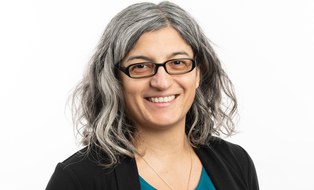 © Sven Ellger/TUD
© Sven Ellger/TUD
Beratung zum Studium im Ausland
NameFrau Federica Serra
Infocenter / TUD weltweit: Amerika, Australien und UK / PROMOS
Eine verschlüsselte E-Mail über das SecureMail-Portal versenden (nur für TUD-externe Personen).
Besuchsadresse:
Fritz Foerster Bau, Büro 156 Mommsenstraße 6
01069 Dresden
Postadresse:
Technische Universität Dresden International Office
01062 Dresden
Sprechzeiten:
- Dienstag:
- 09:30 - 11:30
- 12:30 - 14:30
- Donnerstag:
- 09:30 - 11:30
Bitte im SCS (FOE UG) anmelden.
Du möchtest dich aus erster Hand informieren?
Du willst mehr über Schweden erfahren? Frag die Alumnibotschafter:innen der TU Dresden, die in vielen Ländern der Welt aktiv sind. Sie geben dir gerne Tipps und Hinweise für deinen Aufenthalt.
Kontaktieren ist ganz einfach: Auf der interaktiven Weltkarte zeigen Markierungspunkte die Städte an, in denen die Alumnibotschafter:innen leben. Zu jeder Person ist ein Kurzprofil mit Kontaktinformationen hinterlegt.
Partnerländer Archiv
Hast du ein Partnerland verpasst? Kein Problem! Hier sammeln wir alle Seiten für dich zum Nachlesen.
|
Europa (Erasmus+) |
|
|
Afrika |
|
|
Amerika |
|
|
Asien |
|
|
Australien und Ozeanien |
|

